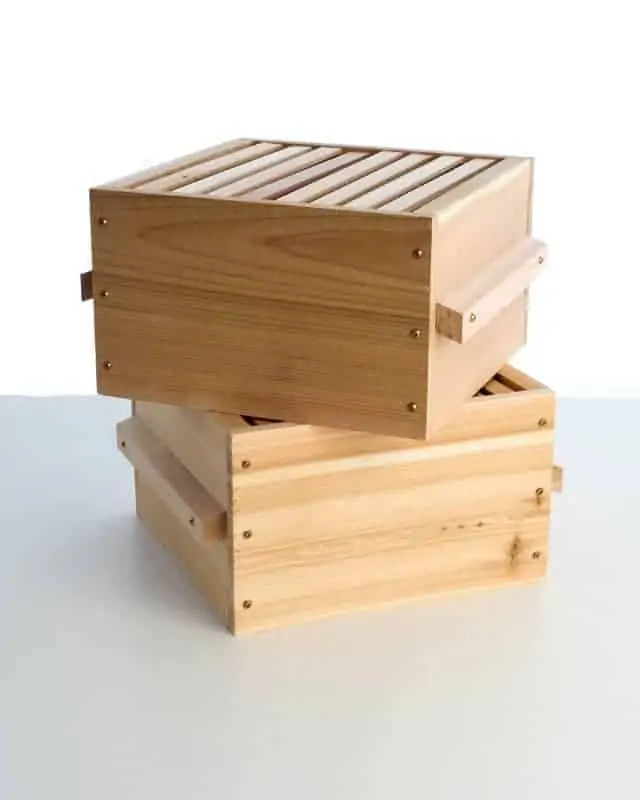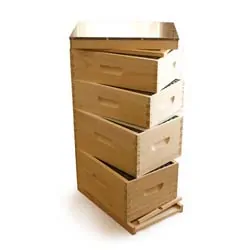In the early 1950s Abbe Emile Warre developed what he called “The People’s Hive” as a result of 50 years of research. He was seeking a non-invasive hive management method that more closely mimicked nature’s way.
The resulting hive was what we now call the Warre beehive.
The Warre is smaller than a Langstroth hive, typically uses top bars, not frames, and mimics a tree trunk.
Components
Roof and shavings box
To aid in insulation and moisture control, the roof of Warre hives is made from thicker wood than the roofs of Langstroth hives. In addition, beneath the roof is a quilt or shavings box which is lined with cotton cloth and filled with wood shavings. Since the roof is rarely, if ever, removed, there’s no need to worry about spilling or contaminating the shavings.
 Hive body box
Hive body box
Similar to the supers in a Langstroth hive, the hive body box is where the bees live, breed, and store honey. Unlike the Langstroth hive, however, additional hive boxes are added to the bottom of the hive.
Unless the beekeeper has chosen to modify for some reason, The warre beehive has boxes that typically contain top bars, not frames. Bees build from the top down, just as they do in nature.
At approximately 12 inches diameter, Warre boxes are closer to the size and shape of a tree trunk than either the Langstroth or horizontal top bar hive.
Floor and entrance
The entrance to a Warre hive is on the bottom, just as with a Langstroth hive. However, it’s smaller than the entrance to a Langstroth hive, avoiding the need to use an entrance reducer. It does, however, make it nearly impossible to use an entrance feeder.
Feeders
Because Warre intended for there to be minimal human interference there isn’t an easy solution to providing food in Warre hives. Some beekeepers will design and build their own top feeder – as the popularity of Warre hives grows, it’s likely these will become commercially available.
Alternatively, a feeder could be placed in an empty super on the bottom of the hive, but it would be difficult to fill.
Operation
Warre hives are not intended to require weekly hive inspections, but some local laws may require it. To use the hive as Warre intended, an additional box, would be added in the spring and perhaps another one or two as the hive continued to grow through the summer.
To prep for winter, the bees will move their honey stores to the top of the hive and position themselves within an appropriate distance, at which point the extra boxes can be removed from the bottom.
To harvest honey, the top box is removed in either spring or fall, depending on your preference. Personally, given the difficulty of feeding bees in this style hive, I’d be inclined to wait until the spring when there’s enough forage available.
For most beeks it’s hard not to get our hands in the hive to check things out and spend time with the swarm. Some Warre beehive users have suggested monthly inspections as it also helps them know when it’s time to add or remove boxes. The more natural set up seems to have a positive impact reducing mites and other hive problems, so it’s unlikely more frequent inspections are needed.
In all cases, make sure to wear your bee gear!
What to look for
If you choose to do inspections and assuming you’re using a top bar approach in the Warre hive, the signs of a healthy hive will be virtually identical to a horizontal top bar hive.
Healthy hive
1. Capped brood comb in a tight, compact pattern with few or no gaps indicates a healthy queen
2. New eggs. These look like tiny grains of rice inside uncapped comb with a clear gel surrounding them. Eggs indicate an active queen within the last 3 days.
3. New comb. White and waxy, new comb indicates an active hive preparing for brood and a healthy honey flow. You will also be able to see signs of this through the viewing window.
4. Nectar, pollen, or honey in the cells proves your foragers are out and doing their jobs.
5. Drone brood in about 10% to 15% of the brood cells. Drones help increase genetic diversity and may also perform environmental control functions within the hive.
Warning signs
1. Supercedure cells. These are queen cups pulled from the center of the comb, rather than the edge, and usually mean the hive has determined the queen is unfit.
2. Swarm cells. Queen cups drawn from the edge of the comb; these typically indicate the hive is preparing to swarm. Swarms are a sign of a healthy hive, but if you’re looking to have more bees or share them with a fellow beekeeper, this is a good time to prepare for a swarm split.
3. Drone brood in more than 20% of brood cells may be signs of a “laying worker” situation where the queen has died or somehow gotten out of the hive and the female (worker) bees have begun laying unfertilized eggs.
4. Signs of disease such as brown-ish eggs in uncapped comb.
Pros and Cons
| Pros | Cons |
|---|---|
| Very low maintenance | Heavy/hard to lift |
| Closer to “nature’s way” | Somewhat more difficult to find a mentor |
| Interchangeable parts | No observation window in the standard design makes it difficult to assess hive activity |
| A “handy” beekeeper can build one | Lower honey yields |
| Less frequent inspections | Requires storage space for empty hive boxes |
Summary
For beekeepers who don’t mind a little heavy lifting and/or those seeking to do things as close to nature as they can, the Warre beehive may be the way to go. They are great for beekeepers seeking to get more pollination in their garden or simply to help the bees, as they’re not known for their honey yields.
Warre beehives are also a good choice for beekeepers who don’t have the time for weekly inspections but still desire backyard bees. For more information, see our Hive and Equipment Choices article.

 Hive body box
Hive body box